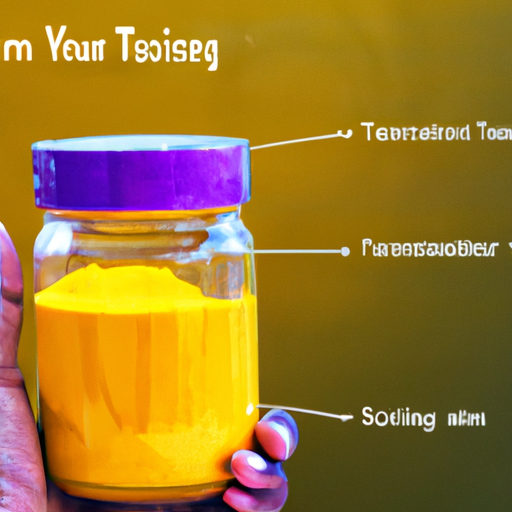Kicking off my mornings with a hot mug of turmeric tea is something I really enjoy. It’s not just tasty, but it’s also packed with a variety of health advantages. Turmeric is rich in curcumin, a potent antioxidant and anti-inflammatory agent that can enhance your immune function and promote better health overall.
Making turmeric tea at home is simple and affordable. All you need are a few basic ingredients and tools, such as fresh or powdered turmeric, ginger, black pepper, honey or lemon to taste, and a pot or kettle to boil water.
In this article, I will show you how to make a basic turmeric tea recipe and share tips on how to customize it to suit your preferences. So grab your favorite mug and let’s get started!
Key Takeaways
- Turmeric tea contains curcumin, a powerful antioxidant and anti-inflammatory compound, which can aid in various health issues such as joint pain, inflammation, and cancer-fighting abilities.
- Making turmeric tea is simple and affordable using basic ingredients like fresh or powdered turmeric, ginger, black pepper, honey or lemon, and a pot or kettle to boil water. Different variations can be made by adding spices like ginger or cinnamon, or customizing it with milk or honey for added flavor and health benefits.
- Turmeric has other uses besides being consumed as tea, such as becoming increasingly popular in skincare due to its antioxidant and anti-inflammatory properties, or being used as a natural dye for fabrics or hair.
- Precautions should be taken when consuming turmeric, as some people may experience allergic reactions or interactions with certain medications. Experimentation may be needed to find the perfect recipe for individual preferences and tastes.
Benefits of Turmeric Tea
You’ll love sipping on turmeric tea because it’s packed with benefits. It can reduce inflammation, aid digestion, and boost your immune system. Turmeric contains curcumin, a compound known for its anti-inflammatory properties. This can help reduce swelling and pain in the body. Inflammation is linked to many chronic diseases such as cancer, heart disease, and diabetes. Drinking turmeric tea regularly can help keep these conditions at bay.
In addition to reducing inflammation, turmeric tea can also boost your immune system. Curcumin has been shown to enhance the activity of immune cells in the body. This helps fight off infections and diseases. It also has antioxidant properties that protect against free radicals that damage cells and contribute to aging.
To reap the full benefits of turmeric tea, it’s important to choose the right type of turmeric. Look for organic or wildcrafted options that are free from pesticides or other harmful chemicals. You can also opt for fresh turmeric root instead of powder for a more potent dose of curcumin. With proper preparation and ingredients, you’ll be able to enjoy all the health benefits this powerful spice has to offer.
Choosing the Right Turmeric
When it comes to choosing the right turmeric for my tea, I always consider whether to use fresh or powdered. Fresh turmeric has a stronger flavor, but it can be harder to find and prepare.
On the other hand, powdered turmeric is more convenient and easier to measure, but its potency may vary depending on how long it has been stored.
In addition, I prefer organic turmeric whenever possible because it’s free from harmful chemicals and pesticides that could potentially harm my health.
Fresh vs. powdered turmeric
Using fresh turmeric root will give your tea a more vibrant and robust flavor, whereas powdered turmeric provides a convenient option for those without access to fresh ingredients.
One of the main differences between using these two forms of turmeric is that fresh turmeric has a higher water content than its powdered counterpart. This means that when cooking with fresh turmeric, you’ll need to use more of it to achieve the same level of intensity as you would with the dried powder.
However, both forms have their advantages. Fresh turmeric contains higher levels of curcumin, which is responsible for many of its health benefits. On the other hand, using powdered turmeric can be more cost-effective and easier to store for longer periods.
When deciding which form to use in your tea, consider what’s available to you and what flavor profile you’re looking for in your beverage.
Now, let’s move on to discussing organic vs. non-organic options for your turmeric tea.
Organic vs. non-organic
If you want to ensure that your turmeric has been grown without harmful pesticides and chemicals, consider choosing organic options for your tea. Organic turmeric is typically cultivated using natural farming methods, which rely on composting, biological pest control, and crop rotation to maintain soil health. This means that your turmeric may contain more nutrients and antioxidants than non-organic varieties.
Choosing organic turmeric can also help address potential health concerns associated with the consumption of non-organic produce. Pesticide residue on non-organic foods has been linked to a variety of negative health effects, including cancer, reproductive issues, and neurological problems.
By selecting organic options for your tea ingredients, you can reduce your exposure to these harmful chemicals while enjoying the many benefits of turmeric tea.
To make a delicious cup of turmeric tea, you’ll need a few simple ingredients and tools.
Ingredients and Tools Needed
To make turmeric tea, all you need is water, ground turmeric, honey, lemon juice, a small saucepan, and a spoon. These ingredients are easy to find in your local grocery store or health food store.
Turmeric has been used for centuries in Ayurvedic medicine and has gained popularity due to its numerous health benefits such as reducing inflammation and aiding digestion. When brewing turmeric tea, it’s important to note that the longer you steep the turmeric in hot water, the stronger the flavor will be. Some people prefer to boil the water with the turmeric first for added potency.
Additionally, adding honey and lemon juice not only enhances the flavor but also provides additional health benefits. Honey can help soothe sore throats while lemon juice is high in vitamin C which helps boost immunity.
Now that we know what ingredients we need and how to brew our tea properly let’s move on to our basic recipe. It’s simple really; In a small saucepan bring 2 cups of water to a boil then add 1 teaspoon of ground turmeric powder. Reduce heat and let simmer for about 10 minutes.
Remove from heat then strain into your favorite mug before adding honey (to taste) and a squeeze of fresh lemon juice.
Basic Turmeric Tea Recipe
So now that we’ve got our ingredients and tools ready, let’s dive into making a basic turmeric tea.
First, I boil some water in a pot and add about a teaspoon of ground turmeric to it. Once the turmeric has dissolved, I let it steep for about 5 minutes before straining it into my mug.
Depending on your preference, you can then add honey, lemon, or milk to taste.
Boiling water and adding turmeric
Once the water has reached boiling point, simply sprinkle in a pinch of turmeric like fairy dust and watch as it transforms into a golden elixir. Boiling techniques can vary depending on your preference, but generally, it is best to use filtered or distilled water to prevent any impurities from affecting the taste. You can also experiment with different tea variations by adding ginger or cinnamon for added flavor and health benefits.
To make sure you get the most out of your turmeric tea, I have included a table that outlines some of its many benefits. Turmeric contains curcumin, which is known for its anti-inflammatory properties and can help with joint pain and arthritis. It also aids in digestion, helps boost immunity, lowers cholesterol levels, and even has potential cancer-fighting abilities.
Now that we have our basic recipe down pat let’s move on to the next step – adding honey, lemon, or milk to enhance both the flavor and nutritional value of our turmeric tea.
Adding honey, lemon, or milk
Enhance the flavor and nutritional value of your turmeric elixir by adding a drizzle of honey, a squeeze of fresh lemon juice, or a splash of creamy milk. These simple additions can transform a basic cup of turmeric tea into a delicious and satisfying beverage with additional health benefits.
Adding spices like cinnamon, ginger, or cardamom can also elevate the taste profile while providing even more therapeutic properties.
Tea bags can be added to the mix for convenience, or you can experiment with blending turmeric with other herbs like chamomile or peppermint for added soothing effects. It’s important to note that different brewing methods will have varying effects on the potency and flavor of your turmeric tea, so it may take some trial and error to find your perfect recipe.
When you’re ready to customize your turmeric tea even further, there are plenty of options available! From adjusting the amount of honey or lemon juice to trying out different milk alternatives like almond or coconut milk, there’s no shortage of ways to make this drink uniquely yours.
So let’s explore some tips for customizing your turmeric tea and creating a beverage that is both delicious and beneficial for your body.
Tips for Customizing Your Turmeric Tea
You can easily customize your turmeric tea by adding a touch of honey or lemon for added flavor. These additions aren’t just tasty, but they also come with their own set of health benefits.
Honey’s known to have antibacterial properties and can soothe sore throats, while lemon’s rich in vitamin C and antioxidants. Another way to customize your turmeric tea is by experimenting with different herbal blends.
Many herbs and spices complement the earthy flavor of turmeric, such as ginger, cinnamon, cardamom, and black pepper. You can try adding these spices to create unique flavor profiles that suit your taste buds.
Lastly, don’t be afraid to get creative with your turmeric tea! You can add milk or coconut milk for a creamy texture or even use it as a base for a latte. The possibilities are endless when it comes to making this healthy beverage your own.
Now that you know how to customize your turmeric tea, let’s talk about how you can store it for optimal freshness.
Storing Turmeric Tea
Now that I’ve learned how to make the perfect cup of turmeric tea, it’s important for me to know how to properly store any leftover tea.
One option is to refrigerate it in an airtight container for up to three days.
Another option is freezing fresh turmeric root for later use in making tea or other recipes.
By following these storage tips, I can ensure that my turmeric tea stays fresh and delicious every time I enjoy it.
Refrigerating leftover tea
If you want to keep your leftover turmeric tea fresh and flavorful, pop it in the fridge! Storing the tea in airtight containers or jars will prevent spoilage and maintain its quality for up to 3 days. However, be sure to drink it within this timeframe as leaving it for too long may cause bacteria growth.
There are many uses for leftover turmeric tea. You can add it to smoothies, use it as a base for soups or stews, or simply reheat and enjoy as is. But if you know that you won’t be able to consume the remaining tea within 3 days, consider freezing it instead of refrigerating.
Freezing turmeric root
To preserve turmeric root for future use, simply peel and chop it into small pieces before placing them in a freezer-safe bag or container. Freezing turmeric root is an excellent way to preserve its freshness and potency.
Here are some benefits of freezing turmeric that you should know:
- Freezing helps to retain the flavor and aroma of the spice.
- Frozen turmeric can be used directly in recipes without thawing.
- You can freeze turmeric for up to six months without losing its beneficial properties.
- Frozen turmeric is perfect for making tea, smoothies, curries, and other dishes.
Creative uses for frozen turmeric root include adding it to your morning smoothie, grating it over roasted vegetables or rice dishes, or using it as a base for homemade curry paste.
Now that you know how to freeze turmeric root, let’s move on to other creative ways you can incorporate this healthy spice into your diet!
Other Uses for Turmeric
Turmeric is a versatile spice that can add health benefits and depth of flavor to many dishes. But did you know that turmeric also has other uses beyond cooking? For instance, turmeric is becoming increasingly popular in skincare due to its antioxidant and anti-inflammatory properties. Some people even use turmeric as a natural remedy for acne or to brighten their skin tone.
In addition to its skincare benefits, turmeric can also be used for a variety of other purposes. For example, some people use it as a natural dye for fabrics or even hair. In traditional Indian medicine, turmeric has been used for centuries as an herbal remedy for various ailments including digestive issues and arthritis. These days, research continues on the potential health benefits of consuming turmeric regularly.
To summarize, while many of us may only think of using turmeric in our cooking, this powerful spice has many other uses worth exploring. From skincare to natural remedies and beyond, there are plenty of reasons to keep some turmeric on hand at all times. However, it’s important to note that like any supplement or ingredient, precautions and side effects should be considered before incorporating it into your routine.
Precautions and Side Effects
Before incorporating turmeric into my diet, I wanted to educate myself on any potential precautions and side effects. It’s important to note that some people may experience allergic reactions when consuming turmeric.
Additionally, turmeric may interact with certain medications such as blood thinners or diabetes medications. Understanding these possible risks can help me make informed decisions about using turmeric in my daily life.
Potential allergic reactions
Be aware that some people may experience allergic reactions to turmeric, so it’s important to proceed with caution and listen to your body’s signals. Common symptoms of an allergic reaction include hives, rash, itching, swelling of the face or throat, difficulty breathing, and stomach upset. If you experience any of these symptoms after drinking turmeric tea or consuming other products containing turmeric, seek medical attention immediately.
Treatment options for allergic reactions to turmeric tea may include antihistamines or epinephrine injections in severe cases. It’s also important to avoid consuming turmeric and products containing it if you know you are allergic. If you still want to benefit from the anti-inflammatory properties of turmeric without risking an allergic reaction, consider alternative supplements like curcumin capsules or powders. With this in mind, let’s now look into how interactions between medications and turmeric can affect your health.
Interactions with medications
Did you know that taking turmeric supplements may interact with certain medications, impacting their effectiveness and potentially causing negative health effects? Turmeric contains curcumin, a compound that can affect how the body metabolizes drugs. It’s important to talk to your healthcare provider before taking turmeric supplements if you’re currently taking any medication.
Some medications that may interact with turmeric include blood thinners like warfarin, anti-inflammatory drugs like aspirin and ibuprofen, and diabetes medication. Turmeric can increase the risk of bleeding when taken with blood thinners, and it may also lower blood sugar levels when taken with diabetes medication. Additionally, some studies suggest that high doses of turmeric may interfere with chemotherapy drugs used for cancer treatment.
Always follow dosage guidelines provided by your healthcare provider or on the supplement label to minimize the risk of adverse reactions or interactions.
Now let’s move on to exploring how drinking turmeric tea can benefit various health conditions.
Turmeric Tea for Health Conditions
Looking to improve your health? Try incorporating turmeric tea into your daily routine! Turmeric has been used for centuries in Ayurvedic and traditional medicine for its numerous health benefits. It contains a powerful antioxidant called curcumin, which has anti-inflammatory properties that can help with a variety of health conditions.
One popular reason people drink turmeric tea is for weight loss. Studies have shown that curcumin can aid in weight management by reducing inflammation and oxidative stress, as well as improving insulin sensitivity. Additionally, drinking turmeric tea before meals may help control appetite and prevent overeating. Just be sure to pair it with a balanced diet and regular exercise for the best results.
Another benefit of turmeric tea is its potential for improving skin health. Curcumin has been found to have antibacterial and anti-inflammatory effects on the skin, making it effective in treating acne, eczema, and psoriasis. Drinking turmeric tea may also help reduce fine lines and wrinkles due to its antioxidant properties.
So, if you’re looking for a natural way to enhance your skin’s appearance, try adding turmeric tea to your skincare regimen!
Frequently Asked Questions
How long does turmeric tea last before it goes bad?
Turmeric tea is a healthy and delicious beverage that comes with many benefits. It’s important to store it properly to avoid it going bad.
The shelf life of turmeric tea varies depending on how you make it and how you store it. If you prepare your tea using fresh ingredients, it will last for about 24 hours in the refrigerator. However, if you use powdered turmeric, the tea can last up to 3-4 days if stored in an airtight container in the fridge.
Some of the benefits of drinking turmeric tea include reducing inflammation, boosting immunity, improving digestion, and promoting healthy skin and hair. To reap these benefits, ensure that you drink freshly brewed turmeric tea or store it correctly so that its potency remains intact.
Can I use ground turmeric instead of fresh turmeric root?
Yes, you can use ground turmeric instead of fresh turmeric root when making turmeric tea. However, it’s important to note that using fresh turmeric root has more benefits than using the ground version. Fresh turmeric root contains a higher concentration of curcumin, which is the active ingredient responsible for its anti-inflammatory and antioxidant properties.
When using ground turmeric, some of the curcumin may have been lost during processing. That being said, using ground turmeric is still a great option if fresh isn’t available or convenient to use. Just make sure to use high-quality organic ground turmeric and store it in an airtight container away from light and heat to preserve its freshness and potency.
Is it possible to make turmeric tea using milk instead of water?
Hey there! I’m a big fan of turmeric tea and I’ve been experimenting with different ways to make it.
One thing I’ve tried is using milk instead of water. It’s definitely possible, but the taste is quite different from traditional turmeric tea made with water.
The milk adds a creaminess and richness that can be appealing, but it also mutes the strong flavor of turmeric somewhat. If you’re someone who loves the bold taste of turmeric, you may not enjoy this substitution as much.
However, if you’re looking for a more mild and comforting drink, give it a try! Just keep in mind that it won’t taste exactly like regular turmeric tea.
What are some common side effects of consuming turmeric tea?
When it comes to consuming turmeric tea, there are some potential side effects to be aware of. Digestive issues, such as stomach pain or diarrhea, can occur if you consume too much turmeric at once.
It’s also possible to experience allergic reactions, especially if you have a sensitivity to other members of the ginger family. However, these side effects are generally rare and most people can safely consume moderate amounts of turmeric tea without issue.
As with any new food or beverage, it’s always a good idea to start with a small amount first and monitor how your body reacts before increasing your intake.
Can turmeric tea help with weight loss?
Turmeric tea is a miracle drink when it comes to weight loss. The benefits of turmeric tea for health are well documented, and it’s able to aid in shedding those extra pounds. Drinking turmeric tea regularly can help you burn fat faster, boost your metabolism, and suppress your appetite.
I’ve personally experienced significant weight loss by incorporating turmeric tea into my daily routine. Not only does it taste delicious, but it also helps me feel full for longer periods of time and reduces my cravings for unhealthy snacks.
If you’re looking to lose weight naturally, try adding turmeric tea to your diet today!
Conclusion
In conclusion, turmeric tea is a delicious and healthy beverage that can easily be incorporated into your daily routine. Not only does it have anti-inflammatory properties, but it can also improve brain function and aid in digestion. By choosing the right type of turmeric and following a basic recipe, you can make your own cup of golden goodness in just minutes.
And with the option to customize with additional ingredients like honey or ginger, you can tailor your tea to suit your taste preferences. As the saying goes, "an ounce of prevention is worth a pound of cure."Incorporating turmeric tea into your diet may help prevent certain health conditions and promote overall wellness.
So why not give it a try? With its warm and comforting flavor, plus its numerous health benefits, turmeric tea may just become your new go-to drink.










